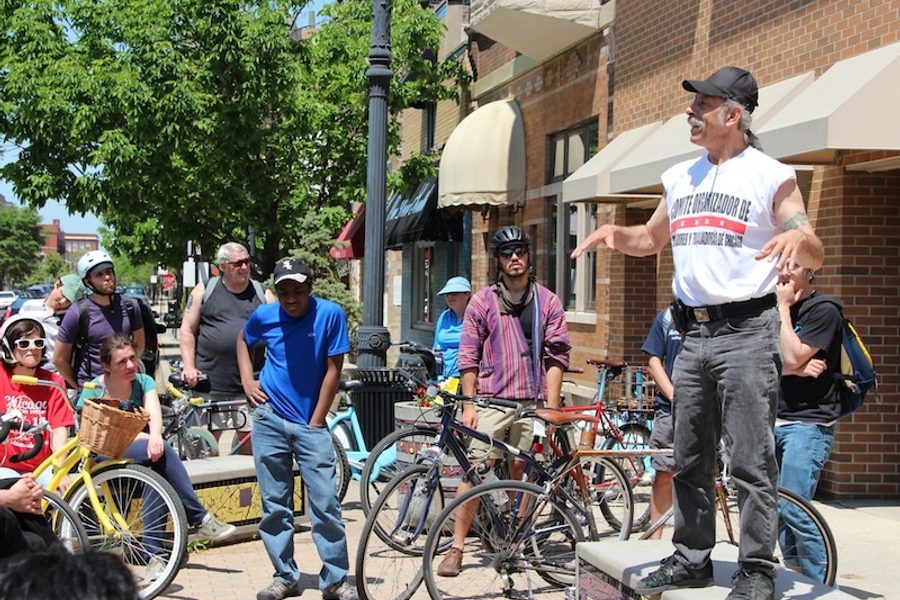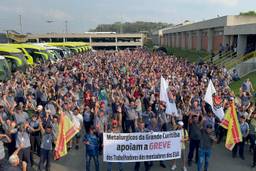
It’s not much to look at today: a cracked, weedy sidewalk in Chicago’s Pilsen neighborhood, just southwest of downtown. Above it run elevated railroad tracks and alongside it, a concrete wall decorated with colorful yet crumbling murals. But in 1877, it was the site of the Battle of the Viaduct, a legendary chapter of labor history wherein thousands of workers — largely Irish, German and other immigrants — chased police out of the neighborhood as part of a national uprising against railroad wage cuts.
The site was showcased Sunday, in the spirit of Memorial Day, on a labor history bike tour that doubled as a fundraiser for a prominent workers’ rights leader challenging the ward’s long-time alderman in the February 2015 election.
Jorge Mujica, an organizer for the workers’ rights group Arise Chicago, is running as an independent socialist against Alderman Danny Solis, a one-time community organizer now known as a major proponent of privatization and a close ally of Mayor Rahm Emanuel.
Mujica’s supporters hope his campaign can recapture even a modest reflection of the fearless, uncompromising and seminal workers’ rights movements that once roiled this neighborhood.
During the 1877 battle, German socialists and Communists streamed into the viaduct from the east and a legion of Irish stockyard workers came up Halsted Street from the south. Police shot into the crowd of protesters, who initially tried to flee but then became enraged as police followed them and kept shooting.
That was the turning point. “The people realized they had the power of numbers, so they turned and chased the police with rocks and cleavers and whatever they had handy,” explained Jerry Boyle, a well-known Chicago civil liberties lawyer, to the bike tour group. “You’re standing on historic ground. The aftermath was that Chicago was radicalized.”
A few blocks south on Halsted Street, the bike tour stopped at a grassy lot next to a hulking, boxy brick building. A century ago, the lot was the site of a Hart, Schaffner & Marx garment shop, and the adjacent building housed a similar operation, part of a garment district where mostly European immigrant women toiled long hours for paltry wages in dangerous conditions. Here, too, a labor uprising took root. In 1910, Hannah Shapiro, a teenage Ukrainian Jewish immigrant working at Hart, Schaffner & Marx, refused to accept a quarter-cent pay cut. The women at the factory stopped work in solidarity, launching weeks of strikes and marches by tens of thousands of the unionized garment workers. While the United Garment Workers Union did not back the action (leading some members to split off and found the progressive Amalgamated Clothing Workers of America), the strike gained support from community and labor groups, and became a symbol of women’s potential power in the labor movement.
Organizer and writer Trish Kahle noted to the tour group that there were highly sexist overtones to the attacks on strikers; and that male fellow workers were initially slow to embrace the movement.
Police and private security guards “manhandled the women to show that women had no place in the workforce,” Kahle explained. “They yelled that they should go home to wash dishes.”
The next stop was just southwest of the garment district, near the Chicago Sanitary and Ship Canal: the former site of McCormick Reaper Works, a factory that made agricultural machines. The bikers gathered at a busy commercial corner to commemorate the confrontation in 1886 that was the spark for the notorious Haymarket Affair. Employees at the Reaper Works had been on strike since February. On May 1, strikes and demonstrations nationwide called for an eight-hour day — the genesis of International Workers’ Day. On May 3, conflict broke out by the Reaper Works picket line as union lumber shovers joined up in solidarity to heckle scabs. Police fired on the crowd of strikers, and up to six workers were killed (accounts of the events vary).
The incident led to the call for the rally the next day that became the Haymarket Affair —a defining moment in labor history when police officers were killed during a melee, prominent anarchist organizers were blamed despite a dearth of evidence, and four of them were ultimately hanged. Speaker Stavroula Harissis read an excerpt from a leaflet composed by Haymarket martyr-to-be August Spies after the Reaper Works confrontation, describing workers slaughtered because they “dared to be dissatisfied with the lot which your oppressors have assigned to them. … They demanded bread, and they gave them lead for an answer.”
The group also stopped in Dvorak Park, one of the neighborhood’s few small green spaces, across the street from the Fisk coal-fired power plant. The plant closed in 2012 after a decade-long campaign by residents and national environmental groups, who denounced the fact that such a heavily polluting operation was located right in the midst of a working-class, mostly Latino immigrant neighborhood.
Jerry Mead Lucero, a leader of the Pilsen Environmental Rights and Reform Organization, pointed out several other environmental justice victories in the neighborhood, including a smelter forced to reduce its emissions and another former smelter site remediated. But he warned of plans backed by Alderman Solis for a new metal recycling operation on the river. Opponents believe the recycling plant would have a serious health and environmental impact, including health risks posed by fine dust that results from metal shredding.
“Unfortunately it seems like every time we have a victory, something new comes up,” said Mead Lucero.
“Can you imagine in [the upscale suburb of] Wilmette or any wealthy neighborhood in Chicago, [someone] saying, ‘Hey, let’s build a metal shredder here?’ ” asked tour organizer and author Joe Allen. He noted that Karen Lewis, the prominent president of the Chicago Teachers Union, has spoken out against the proposed shredder.
Next to the Pilsen neighborhood is Chicago’s Chinatown, part of the same aldermanic ward. In Chinatown, the bike tour featured Dennis Kosuth, an emergency room union nurse at the public county hospital, speaking about the history of Chinese workers in the city. He noted that Chinese immigrants came to Chicago after working on the railroads, and also fleeing racism on the west coast — fueled in part by labor unions that didn’t want to compete with Chinese immigrants for jobs.
The bike tour also highlighted how the hardscrabble yet highly organized workers and families in Pilsen fought successfully for basic rights and services, and to create an indelible mark on their neighborhood. The group stopped at Benito Juarez Community Academy, a high school built in 1977 as a result of a mass movement demanding a new school. The tour viewed Pilsen’s famous public murals and mosaics, which celebrate the immigrant community, popular struggles and everyday life. And the tour started at a local library named for Rudy Lozano, a leader with the International Ladies Garment Workers Union and immigrants rights activist, who was slain in his home in 1983. Mujica noted that city officials planned to name the library for a former Mexican official who played a role in the end of the bracero worker program in 1964 and the wave of deportations that followed. The community demanded the library be named to commemorate Lozano instead.
“Rudy Lozano’s death exemplified the abrupt end to radical politics in Chicago in that era,” activist Mario Cardenas told the group. Four years later, legendary African American Mayor Harold Washington — whom Lozano had helped elect — died in office. In 1989, Mayor Richard M. Daley was elected, and Chicago embraced an agenda of privatization while the power of unions and popular movements declined – reflecting the national trends starting in the 1980s under President Ronald Reagan. But with today’s ongoing electoral campaign and other contemporary struggles, organizers and residents in Pilsen hope to revive popular movements in the months and years to come.

I hope you found this article important. Before you leave, I want to ask you to consider supporting our work with a donation. In These Times needs readers like you to help sustain our mission. We don’t depend on—or want—corporate advertising or deep-pocketed billionaires to fund our journalism. We’re supported by you, the reader, so we can focus on covering the issues that matter most to the progressive movement without fear or compromise.
Our work isn’t hidden behind a paywall because of people like you who support our journalism. We want to keep it that way. If you value the work we do and the movements we cover, please consider donating to In These Times.
Kari Lydersen is a Chicago-based journalist, author and assistant professor at Northwestern University, where she leads the investigative specialization at the Medill School of Journalism, Media, Integrated Marketing Communications. Her books include Mayor 1%: Rahm Emanuel and the Rise of Chicago’s 99%.







